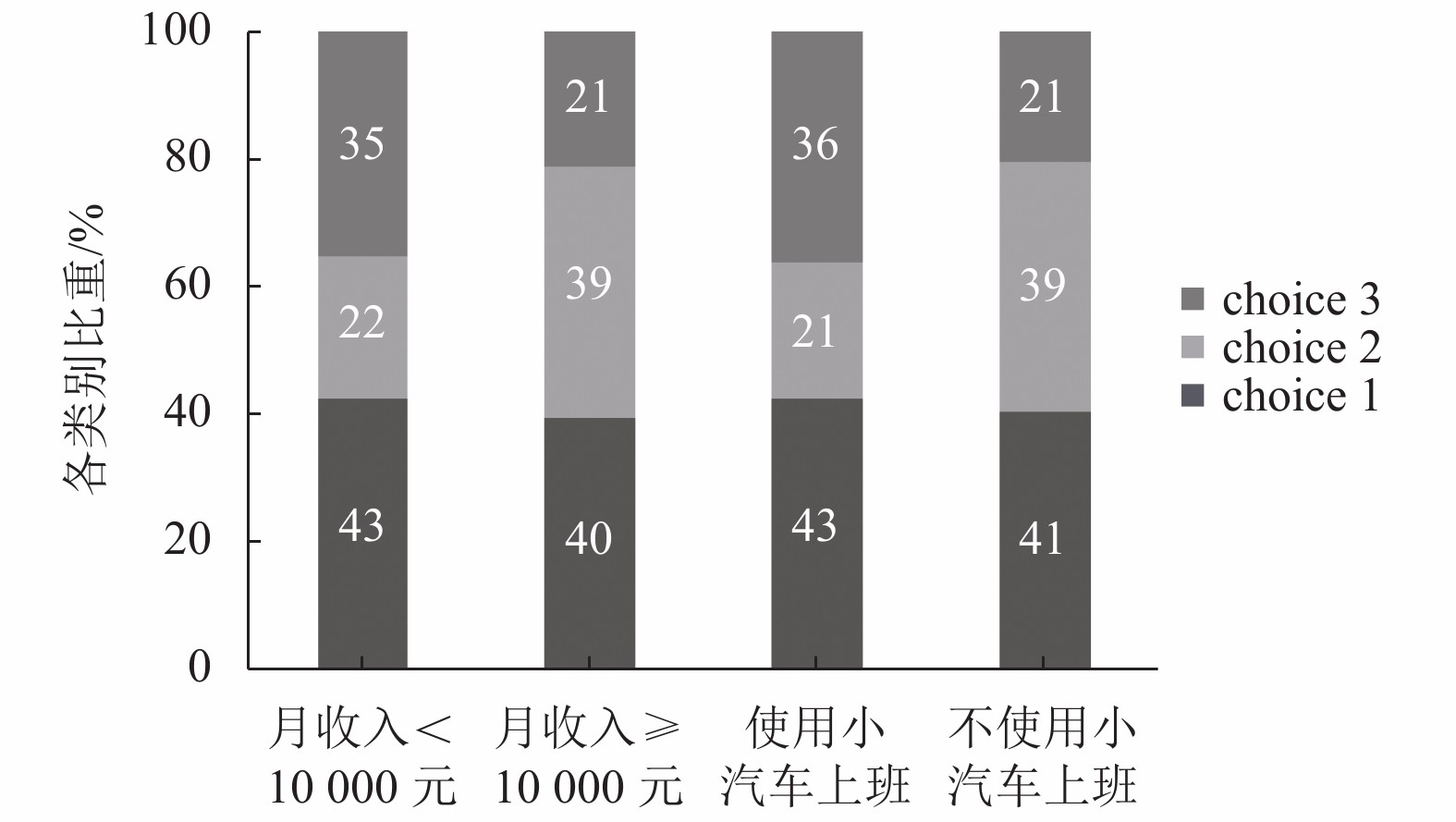Inclusion of Latent Class in Behavior Model of Motorized Travel in City
-
摘要: 为了研究出行者出行选择偏好的异质性和心理因素对出行选择行为的影响,通过验证性因子分析得到影响出行方式选择的心理潜变量;将求得的潜变量纳入潜在类别条件Logit模型,采用期望最大算法求解,得到样本潜在类别的数量和效用函数;最后,以广州市为例进行实证分析. 结果表明:潜在类别条件Logit模型对数据的拟合度高于传统的条件Logit模型;出行者可以划分为地铁偏好群体、小汽车偏好群体、常规公交偏好群体3个潜在类别,占比分别为42.5%、25.0%、32.5%;地铁偏好群体、公交偏好群体步行时间价值分别为1.2、1.3元/min,而小汽车偏好群体对步行持正面评价;地铁偏好群体、公交偏好群体的时间价值均为0.7元/min,小于小汽车偏好群体的车内时间价值(1.1元/min);月收入是否大于10 000元、是否开车上班对出行者潜在类别划分具有显著影响;心理潜变量中,灵活性和可靠性对出行者潜在类别划分的影响显著,舒适性对潜在类别划分没有显著影响.
-
关键词:
- 时间价值 /
- 潜在类别条件Logit模型 /
- 心理因素
Abstract: To study the preference heterogeneity of travel choice and the influence of psychological factors on travel behavior, the psychological latent variables that influence the travel mode choice are obtained through confirmatory factor analysis. Then, these variables are introduced into latent-class conditional Logit model, which is solved by the expectation-maximization algorithm to obtain the number of latent classes and the utility function. Finally, Guangzhou is used as an example for empirical analysis. The results show that the latent-class conditional Logit model has higher fitness than the traditional conditional Logit model. For three travelers’ groups: the metro-preference, car-preference, and bus-preference groups, which account for 42.5%, 25.0% and 32.5%, respectively. The walking time value of the metro-preference and bus-preference groups is 1.2 Yuan/min and 1.3 Yuan/min, respectively, while t the car-preference group evaluate the walking positively. The time value of the metro-preference and bus-preference groups is 0.7 Yuan/min, which is less than that of the car-preference group of 1.1 Yuan/min. Whether the monthly income is more than 10000 Yuan and whether the travelers commute by car have a significant influence on the latent class classification. Of all psychological factors, flexibility and reliability have a significant influence on the latent class classification, while comfort have no significant influence.-
Key words:
- time value /
- latent-class conditional Logit model /
- psychological factor
-
表 1 SP情景示例
Table 1. Example of SP choice scenario
出行方式 费用/元 时间/min 小汽车 油价 + 停车费:14.0 开车时间:10 公交车 车票价格:1.5 走路到公交站时间:9 车内时间:35 地铁 车票价格:5.0 走路到地铁站时间:12 车内时间:15 表 2 表征心理潜变量的显变量
Table 2. Manifest variables to indicate psychological latent variables
潜变量 显变量 符号 lc 车辆运行稳定很重要 c1 车厢内的气味、温度、噪声很重要 c2 出行途中可以看手机或书很重要 c3 出行途中可以休息或放松很重要的 c4 lr 会考虑出行方式的准点率 r1 尽量避开时不时晚点的出行方式 r2 即使多花 10 min 以上,尽量避开经常晚点的交通方式 r3 尽量选择准点但不舒服的交通出行方式 r4 lf 出行方式的便利性很重要 f1 如果到达公交站的步行时间超过 10 min,我会选择其他交通方式 f2 如果到达地铁站的步行时间超过 15 min,我会选择其他交通方式 f3 如果候车时间太长,我会选择其他交通方式 f4 表 3 模型拟合度指标
Table 3. Fitness statistics of model
类别 RMSEA CFI TLI SRMR 模型值 0.076 0.950 0.931 0.041 参考值[20] ≤ 0.080 ≥ 0.900 ≥ 0.900 < 0.080 表 4 验证性因子分析模型结果
Table 4. Results of confirmatory factor analysis
潜变量 显变量 标准化系数 Z 值 P 值 lc c1 0.753 39.72 0 c2 0.830 50.55 0 c3 0.391 12.16 0 c4 0.793 44.16 0 lr r1 0.840 56.56 0 r2 0.776 45.43 0 r3 0.795 47.70 0 r4 0.659 29.39 0 lf f1 0.696 18.77 0 f2 0.529 14.30 0 f3 0.669 22.91 0 f4 0.945 29.67 0 表 5 模型CAIC及BIC比较
Table 5. Comparison of CAIC and BIC values
类别 CAIC BIC 2 5 905 5 882 3 5 620 5 568 4 5 627 5 579 5 5 657 5 580 6 5 709 5 614 表 6 潜在类别条件Logit模型回归系数
Table 6. Regression coefficient of latent-class conditional Logit model
类别 变量 标准化系数 Z 值 P 值 choice 1 f −0.107 −4.34 0 w −0.130 −2.81 0.005 v −0.076 −6.14 0 dbus 0.212 0.29 0.772 dmetro 3.075 3.77 0 choice 2 f −0.121 −7.08 0 w 0.100 2.48 0.013 v −0.129 −5.10 0 dbus −7.484 −4.55 0 dmetro −3.672 −6.09 0 choice 3 f −0.045 −3.67 0 w −0.058 −3.19 0.001 v −0.031 −4.09 0 dbus 0.894 2.77 0.006 dmetro 0.622 2.42 0.015 表 7 出行者特征对类别的影响
Table 7. Impact of travelers’ demographic characteristics on latent class
类别 变量 标准化系数 Z 值 P 值 choice 1 zfem 0.529 2.22 0.026 zmar −0.370 −1.34 0.181 zinc5 −0.332 −1.14 0.255 zinc10 0.817 2.00 0.045 zcar −0.360 −1.28 0.202 zhou 0.212 0.76 0.446 zc2work 0.669 1.70 0.089 zb2work −0.590 −2.28 0.022 zm2work 0.785 3.02 0.003 lf 0.874 3.72 0 lc 0.319 1.29 0.196 lr 0.601 2.49 0.013 zcons 0.076 0.26 0.797 choice 2 zfem 0.375 1.49 0.135 zmar −0.881 −2.97 0.003 zinc5 0.267 0.88 0.378 zinc10 1.022 2.52 0.012 zcar 0.560 1.76 0.079 zhou −0.371 −1.28 0.201 zc2work 0.990 2.47 0.013 zb2work −0.223 −0.80 0.422 zm2work 0.053 0.19 0.850 lf 1.000 3.94 0 lc 0.008 0.04 0.971 lr 0.101 0.44 0.662 zcons −0.490 −1.50 0.132 表 8 相对系数对比
Table 8. Comparison of relative coefficient
项目 $\dfrac{w}{f} \Bigg /\left( { {\simfont\text{元} }{\simfont\text{•} } {\rm{min} }^{-1} } \right)$ $\dfrac{v}{f} \Bigg /\left( { {\simfont\text{元} }{\simfont\text{•} } {\rm{min} }^{-1} } \right)$ dbus dmetro choice 1 1.2 0.7 — −28.8 choice 2 −0.8 1.1 62.0 30.4 choice 3 1.3 0.7 −20.0 −13.9 整体 0.6 0.8 14.3 −8.2 注: choice 1 中的 dbus 的系数不显著,故未列出. -
宗芳,隽志才,张慧永. 出行时间价值计算及应用研究[J]. 交通运输系统工程与信息,2009,9(3): 114-119. doi: 10.3969/j.issn.1009-6744.2009.03.018ZONG Fang, JUAN Zhicai, ZHANG Huiyong. Calculation and application of value of travel time[J]. Journal of Transportation Systems Engineering and Information Technology, 2009, 9(3): 114-119. doi: 10.3969/j.issn.1009-6744.2009.03.018 秦萍,陈颖翱,徐晋涛. 北京居民出行行为分析:时间价值和交通需求弹性估算[J]. 经济地理,2014,34(11): 17-22.QIN Ping, CHEN Yinao, XU Jintao. Travel behavior analysis for the residents in Beijing:value of time and travel dem and elasticity estimates[J]. Economic Geography, 2014, 34(11): 17-22. CHENG Y H, CHEN S Y. Perceived accessibility,mobility,and connectivity of public transportation systems[J]. Transportation Research Part A:Policy and Practice, 2015, 77(7): 386-403. CHENG Y H, LIU K C. Evaluating bicycle-transit users’ perceptions of intermodal inconvenience[J]. Transportation Research Part A:Policy and Practice, 2012, 46(10): 1690-1706. doi: 10.1016/j.tra.2012.10.013 BHAT C R. An endogenous segmentation mode choice model with an application to intercity travel[J]. Transportation Science, 1997, 31(1): 34-48. doi: 10.1287/trsc.31.1.34 TEMME D, PAULSSEN M, DANNEWALD T. Incorporating latent variables into discrete choice models—a simultaneous estimation approach using SEM software[J]. Business Research, 2008, 1(2): 220-237. doi: 10.1007/BF03343535 YÁÑEZ M F, RAVEAU S, ORTÚZAR J D D. Inclusion of latent variables in mixed logit models:modelling and forecasting[J]. Transportation Research Part A:Policy and Practice, 2010, 44(9): 744-753. doi: 10.1016/j.tra.2010.07.007 景鹏,隽志才,查奇芬. 考虑心理潜变量的出行方式选择行为模型[J]. 中国公路学报,2014,27(11): 84-92,108. doi: 10.3969/j.issn.1001-7372.2014.11.012JING Peng, JUAN Zhicai, ZHA Qifen. Incorporating psychological latent variables into travel mode choice model[J]. China Journal of Highway & Transport, 2014, 27(11): 84-92,108. doi: 10.3969/j.issn.1001-7372.2014.11.012 SARRIAS M, DAZIANO R. Multinomial logit models with continuous and discrete individual heterogeneity in R:the gmnl package[J]. Journal of Statistical Software, 2017, 79(2): 1-46. SARRIAS M. Discrete choice models with random parameters in R:the Rchoice package[J]. Journal of Statistical Software, 2016, 74(10): 1-31. MA T Y, GERBER P, CARPENTIER S, et al. Mode choice with latent preference heterogeneity:a case study for employees of the EU institutions in Luxembourg[J]. Transportmetrica A:Transport Science, 2015, 11(5): 441-463. doi: 10.1080/23249935.2015.1007175 HAGHANI M, SARVI M. Identifying latent classes of pedestrian crowd evacuees[J]. Transportation Research Record:Journal of the Transportation Research Board, 2016, 2560(1): 67-74. WEN C H, WANG W C, FU C. Latent class nested logit model for analyzing high-speed rail access mode choice[J]. Transportation Research Part E:Logistics and Transportation Review, 2012, 48(2): 545-554. doi: 10.1016/j.tre.2011.09.002 KIM S H, MOKHTARIAN P L. Taste heterogeneity as an alternative form of endogeneity bias:investigating the attitude-moderated effects of built environment and socio-demographics on vehicle ownership using latent class modeling[J]. Transportation Research Part A:Policy and Practice, 2018, 116(10): 130-150. TRAIN K E. EM algorithms for nonparametric estimation of mixing distributions[J]. Journal of Choice Modelling, 2008, 1(1): 40-69. doi: 10.1016/S1755-5345(13)70022-8 PACIFICO D, YOO H I. Lclogit:a stata command for fitting latent-class conditional logit models via the expectation-maximization algorithm[J]. Stata Journal, 2013, 13(3): 625-639. doi: 10.1177/1536867X1301300312 DE PALMA A, KILANI M, PROOST S. Discomfort in mass transit and its implication for scheduling and pricing[J]. Transportation Research Part B:Methodological, 2015, 71: 1-18. KOU W, CHEN X, YU L, et al. Urban commuters’ valuation of travel time reliability based on stated preference survey:a case study of Beijing[J]. Transportation Research Part A:Policy and Practice, 2017, 95(1): 372-380. RAYLE L, DAI D, CHAN N, et al. Just a better taxi? A survey-based comparison of taxis,transit,and ridesourcing services in San Francisco[J]. Transport Policy, 2016, 45(1): 168-178. JICHUANG W, XIAOQIAN W. Structural equation modeling: applications using Mplus[M]. London: John Wiley & Sons, 2019: 19-26. -





 下载:
下载:

